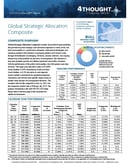Download Our Performance Reports
 4Thought Financial Group’s separate account strategies are managed with repeatable algorithmic processes so they can be consistently competitive. See how the actual client accounts in each strategy have performed.
4Thought Financial Group’s separate account strategies are managed with repeatable algorithmic processes so they can be consistently competitive. See how the actual client accounts in each strategy have performed.
Bond Mutual Funds:
- Have no final maturity date, and therefore act more like a variable/equity investment in the bond market, as opposed to owning true “fixed income”. There is no assurance at all of the future value of the holding without a maturity date, so if interest rates rise and the market value of the bond mutual fund declines, the investor has an indefinite wait until the market comes back, and will receive only what the market value provides on a premature sale.
- They have relatively low default risk due to their underlying exposures to a large number of individual bond issues, so that if one or a few of them default, there are unlikely to be catastrophic losses to the overall portfolio.
- Mutual funds are a pooled investment vehicle, so by pooling money with other investors to achieve pricing power and economies of scale, it is possible to build a very broadly diversified portfolio with only a small initial investment – as little as $5,000 or even less. Even this relatively simple approach will optimally include the use of an investment professional of some sort to create and manage a diversified bond portfolio on an ongoing basis.
Individual bonds:
- Can be purchased and held to maturity to get back principal plus interest, even if during the interim period the market value fluctuates wildly due to interest rate environment changes. (This is of course subject to specific bond characteristics such as “make-whole calls”, as well as the assumption of no default).
- They are subject to default by the issuer, who can fail to make interest payments or to repay principal (in whole or in part), potentially nullifying the ability to hold to maturity in the worst case.
- Since individual bonds typically may only be purchased in large tranches, in order to achieve an appropriate level of portfolio diversity (needed to reduce the risk of default on any single bond issue), a significant amount of investable assets are required (usually in the millions of dollars) and a specialized bond manager is strongly recommended.
So while both of these types of bond market exposure have their uses, they both have significant drawbacks. Enter the ETF (exchange traded fund) – and specifically, the Target Date Bond ETF. The latter is a relatively little-known type of security that’s been available only for a little over a decade. Some features of these types of securities are as follows:
Target Date Bond Exchange Traded Funds:
- Can be purchased and held to maturity to get back principal plus interest, even if during the interim period the market value fluctuates wildly due to interest rate environment changes. This is due to the security’s structure, in which the ETF itself has a maturity date (at which point it converts to cash). It is composed of a large number of underlying individual fixed income securities, all of which are scheduled to mature and convert to cash on or before the end-date of the ETF itself.
- They have relatively low default risk due to their underlying exposures to a large number of individual bond issues, so that if one or a few of them default, there are unlikely to be catastrophic losses to the overall portfolio (which is not the case with an insufficiently diversified individual securities portfolio).
- Exchange Traded Funds are a pooled investment vehicle like mutual funds, so by pooling funds with other investors to achieve pricing power and economies of scale, it is possible to build a very broadly diversified portfolio with only a small initial investment – also as little as $5,000 or even less. This approach also will require the use of a professional investment advisor or money manager to create and manage the portfolio on an ongoing basis.
When used properly in conjunction with appropriate laddering and accompanying diversifying bond types, Target Date Bond ETFs can provide a little of the best of both worlds, in that they combine the ability to hold to maturity (of an individual bond) with the diversity, lower default risk, and lower initial investments of bond mutual funds. When used in this way, these securities can go a long way towards protecting your clients from potential interest rate rises (and from themselves). So why aren’t more investors and advisors using these securities? The answer is simple: They haven’t done enough research to know that they even exist.
If you have clients who you think could benefit from a discussion on this topic, please contact 4Thought Financial Group Inc.






Leave a Comment